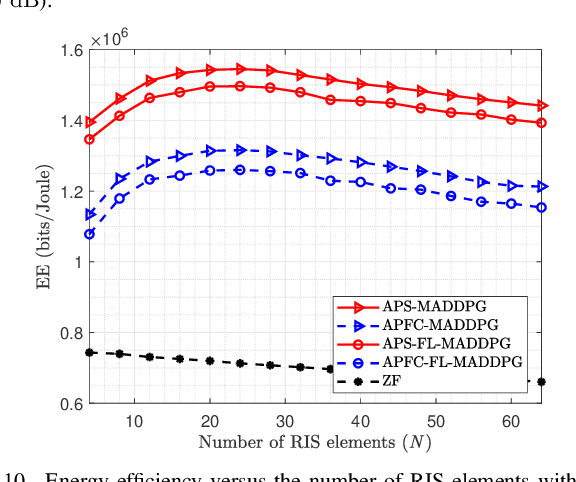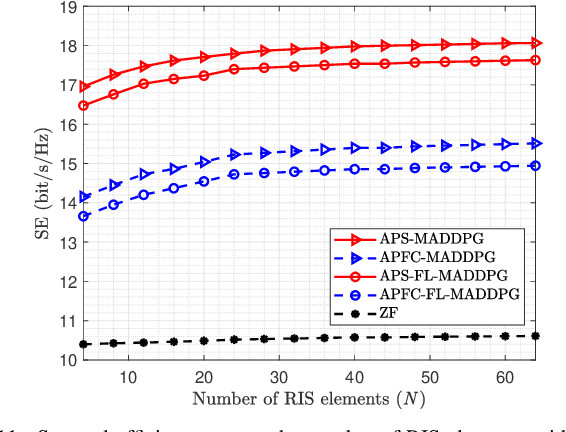Ziheng Liu
Channel Estimation for Rydberg Atomic Receivers
Mar 12, 2025Abstract:The rapid development of the quantum technology presents huge opportunities for 6G communications. Leveraging the quantum properties of highly excited Rydberg atoms, Rydberg atom-based antennas present distinct advantages, such as high sensitivity, broad frequency range, and compact size, over traditional antennas. To realize efficient precoding, accurate channel state information is essential. However, due to the distinct characteristics of atomic receivers, traditional channel estimation algorithms developed for conventional receivers are no longer applicable. To this end, we propose a novel channel estimation algorithm based on projection gradient descent (PGD), which is applicable to both one-dimensional (1D) and twodimensional (2D) arrays. Simulation results are provided to show the effectiveness of our proposed channel estimation method.
Joint Power Allocation and Phase Shift Design for Stacked Intelligent Metasurfaces-aided Cell-Free Massive MIMO Systems with MARL
Feb 27, 2025Abstract:Cell-free (CF) massive multiple-input multiple-output (mMIMO) systems offer high spectral efficiency (SE) through multiple distributed access points (APs). However, the large number of antennas increases power consumption. We propose incorporating stacked intelligent metasurfaces (SIM) into CF mMIMO systems as a cost-effective, energy-efficient solution. This paper focuses on optimizing the joint power allocation of APs and the phase shift of SIMs to maximize the sum SE. To address this complex problem, we introduce a fully distributed multi-agent reinforcement learning (MARL) algorithm. Our novel algorithm, the noisy value method with a recurrent policy in multi-agent policy optimization (NVR-MAPPO), enhances performance by encouraging diverse exploration under centralized training and decentralized execution. Simulations demonstrate that NVR-MAPPO significantly improves sum SE and robustness across various scenarios.
Personalized Dynamic Music Emotion Recognition with Dual-Scale Attention-Based Meta-Learning
Dec 26, 2024Abstract:Dynamic Music Emotion Recognition (DMER) aims to predict the emotion of different moments in music, playing a crucial role in music information retrieval. The existing DMER methods struggle to capture long-term dependencies when dealing with sequence data, which limits their performance. Furthermore, these methods often overlook the influence of individual differences on emotion perception, even though everyone has their own personalized emotional perception in the real world. Motivated by these issues, we explore more effective sequence processing methods and introduce the Personalized DMER (PDMER) problem, which requires models to predict emotions that align with personalized perception. Specifically, we propose a Dual-Scale Attention-Based Meta-Learning (DSAML) method. This method fuses features from a dual-scale feature extractor and captures both short and long-term dependencies using a dual-scale attention transformer, improving the performance in traditional DMER. To achieve PDMER, we design a novel task construction strategy that divides tasks by annotators. Samples in a task are annotated by the same annotator, ensuring consistent perception. Leveraging this strategy alongside meta-learning, DSAML can predict personalized perception of emotions with just one personalized annotation sample. Our objective and subjective experiments demonstrate that our method can achieve state-of-the-art performance in both traditional DMER and PDMER.
Mobile Cell-Free Massive MIMO with Multi-Agent Reinforcement Learning: A Scalable Framework
Dec 03, 2024



Abstract:Cell-free massive multiple-input multiple-output (mMIMO) offers significant advantages in mobility scenarios, mainly due to the elimination of cell boundaries and strong macro diversity. In this paper, we examine the downlink performance of cell-free mMIMO systems equipped with mobile-APs utilizing the concept of unmanned aerial vehicles, where mobility and power control are jointly considered to effectively enhance coverage and suppress interference. However, the high computational complexity, poor collaboration, limited scalability, and uneven reward distribution of conventional optimization schemes lead to serious performance degradation and instability. These factors complicate the provision of consistent and high-quality service across all user equipments in downlink cell-free mMIMO systems. Consequently, we propose a novel scalable framework enhanced by multi-agent reinforcement learning (MARL) to tackle these challenges. The established framework incorporates a graph neural network (GNN)-aided communication mechanism to facilitate effective collaboration among agents, a permutation architecture to improve scalability, and a directional decoupling architecture to accurately distinguish contributions. In the numerical results, we present comparisons of different optimization schemes and network architectures, which reveal that the proposed scheme can effectively enhance system performance compared to conventional schemes due to the adoption of advanced technologies. In particular, appropriately compressing the observation space of agents is beneficial for achieving a better balance between performance and convergence.
Joint Precoding and AP Selection for Energy Efficient RIS-aided Cell-Free Massive MIMO Using Multi-agent Reinforcement Learning
Nov 17, 2024



Abstract:Cell-free (CF) massive multiple-input multiple-output (mMIMO) and reconfigurable intelligent surface (RIS) are two advanced transceiver technologies for realizing future sixth-generation (6G) networks. In this paper, we investigate the joint precoding and access point (AP) selection for energy efficient RIS-aided CF mMIMO system. To address the associated computational complexity and communication power consumption, we advocate for user-centric dynamic networks in which each user is served by a subset of APs rather than by all of them. Based on the user-centric network, we formulate a joint precoding and AP selection problem to maximize the energy efficiency (EE) of the considered system. To solve this complex nonconvex problem, we propose an innovative double-layer multi-agent reinforcement learning (MARL)-based scheme. Moreover, we propose an adaptive power threshold-based AP selection scheme to further enhance the EE of the considered system. To reduce the computational complexity of the RIS-aided CF mMIMO system, we introduce a fuzzy logic (FL) strategy into the MARL scheme to accelerate convergence. The simulation results show that the proposed FL-based MARL cooperative architecture effectively improves EE performance, offering a 85\% enhancement over the zero-forcing (ZF) method, and achieves faster convergence speed compared with MARL. It is important to note that increasing the transmission power of the APs or the number of RIS elements can effectively enhance the spectral efficiency (SE) performance, which also leads to an increase in power consumption, resulting in a non-trivial trade-off between the quality of service and EE performance.
Cooperative Multi-Target Positioning for Cell-Free Massive MIMO with Multi-Agent Reinforcement Learning
Oct 09, 2024



Abstract:Cell-free massive multiple-input multiple-output (mMIMO) is a promising technology to empower next-generation mobile communication networks. In this paper, to address the computational complexity associated with conventional fingerprint positioning, we consider a novel cooperative positioning architecture that involves certain relevant access points (APs) to establish positioning similarity coefficients. Then, we propose an innovative joint positioning and correction framework employing multi-agent reinforcement learning (MARL) to tackle the challenges of high-dimensional sophisticated signal processing, which mainly leverages on the received signal strength information for preliminary positioning, supplemented by the angle of arrival information to refine the initial position estimation. Moreover, to mitigate the bias effects originating from remote APs, we design a cooperative weighted K-nearest neighbor (Co-WKNN)-based estimation scheme to select APs with a high correlation to participate in user positioning. In the numerical results, we present comparisons of various user positioning schemes, which reveal that the proposed MARL-based positioning scheme with Co-WKNN can effectively improve positioning performance. It is important to note that the cooperative positioning architecture is a critical element in striking a balance between positioning performance and computational complexity.
Distributed Collaborative User Positioning for Cell-Free Massive MIMO with Multi-Agent Reinforcement Learning
Oct 07, 2024



Abstract:In this paper, we investigate a cell-free massive multiple-input multiple-output system, which exhibits great potential in enhancing the capabilities of next-generation mobile communication networks. We first study the distributed positioning problem to lay the groundwork for solving resource allocation and interference management issues. Instead of relying on computationally and spatially complex fingerprint positioning methods, we propose a novel two-stage distributed collaborative positioning architecture with multi-agent reinforcement learning (MARL) network, consisting of a received signal strength-based preliminary positioning network and an angle of arrival-based auxiliary correction network. Our experimental results demonstrate that the two-stage distributed collaborative user positioning architecture can outperform conventional fingerprint positioning methods in terms of positioning accuracy.
Joint SIM Configuration and Power Allocation for Stacked Intelligent Metasurface-assisted MU-MISO Systems with TD3
Aug 11, 2024Abstract:The stacked intelligent metasurface (SIM) emerges as an innovative technology with the ability to directly manipulate electromagnetic (EM) wave signals, drawing parallels to the operational principles of artificial neural networks (ANN). Leveraging its structure for direct EM signal processing alongside its low-power consumption, SIM holds promise for enhancing system performance within wireless communication systems. In this paper, we focus on SIM-assisted multi-user multi-input and single-output (MU-MISO) system downlink scenarios in the transmitter. We proposed a joint optimization method for SIM phase shift configuration and antenna power allocation based on the twin delayed deep deterministic policy gradient (TD3) algorithm to efficiently improve the sum rate. The results show that the proposed algorithm outperforms both deep deterministic policy gradient (DDPG) and alternating optimization (AO) algorithms. Furthermore, increasing the number of meta-atoms per layer of the SIM is always beneficial. However, continuously increasing the number of layers of SIM does not lead to sustained performance improvement.
Double-Layer Power Control for Mobile Cell-Free XL-MIMO with Multi-Agent Reinforcement Learning
Sep 29, 2023Abstract:Cell-free (CF) extremely large-scale multiple-input multiple-output (XL-MIMO) is regarded as a promising technology for enabling future wireless communication systems. Significant attention has been generated by its considerable advantages in augmenting degrees of freedom. In this paper, we first investigate a CF XL-MIMO system with base stations equipped with XL-MIMO panels under a dynamic environment. Then, we propose an innovative multi-agent reinforcement learning (MARL)-based power control algorithm that incorporates predictive management and distributed optimization architecture, which provides a dynamic strategy for addressing high-dimension signal processing problems. Specifically, we compare various MARL-based algorithms, which shows that the proposed MARL-based algorithm effectively strikes a balance between spectral efficiency (SE) performance and convergence time. Moreover, we consider a double-layer power control architecture based on the large-scale fading coefficients between antennas to suppress interference within dynamic systems. Compared to the single-layer architecture, the results obtained unveil that the proposed double-layer architecture has a nearly24% SE performance improvement, especially with massive antennas and smaller antenna spacing.
Cell-Free XL-MIMO Meets Multi-Agent Reinforcement Learning: Architectures, Challenges, and Future Directions
Jul 06, 2023Abstract:Cell-free massive multiple-input multiple-output (mMIMO) and extremely large-scale MIMO (XL-MIMO) are regarded as promising innovations for the forthcoming generation of wireless communication systems. Their significant advantages in augmenting the number of degrees of freedom have garnered considerable interest. In this article, we first review the essential opportunities and challenges induced by XL-MIMO systems. We then propose the enhanced paradigm of cell-free XL-MIMO, which incorporates multi-agent reinforcement learning (MARL) to provide a distributed strategy for tackling the problem of high-dimension signal processing and costly energy consumption. Based on the unique near-field characteristics, we propose two categories of the low-complexity design, i.e., antenna selection and power control, to adapt to different cell-free XL-MIMO scenarios and achieve the maximum data rate. For inspiration, several critical future research directions pertaining to green cell-free XL-MIMO systems are presented.
 Add to Chrome
Add to Chrome Add to Firefox
Add to Firefox Add to Edge
Add to Edge